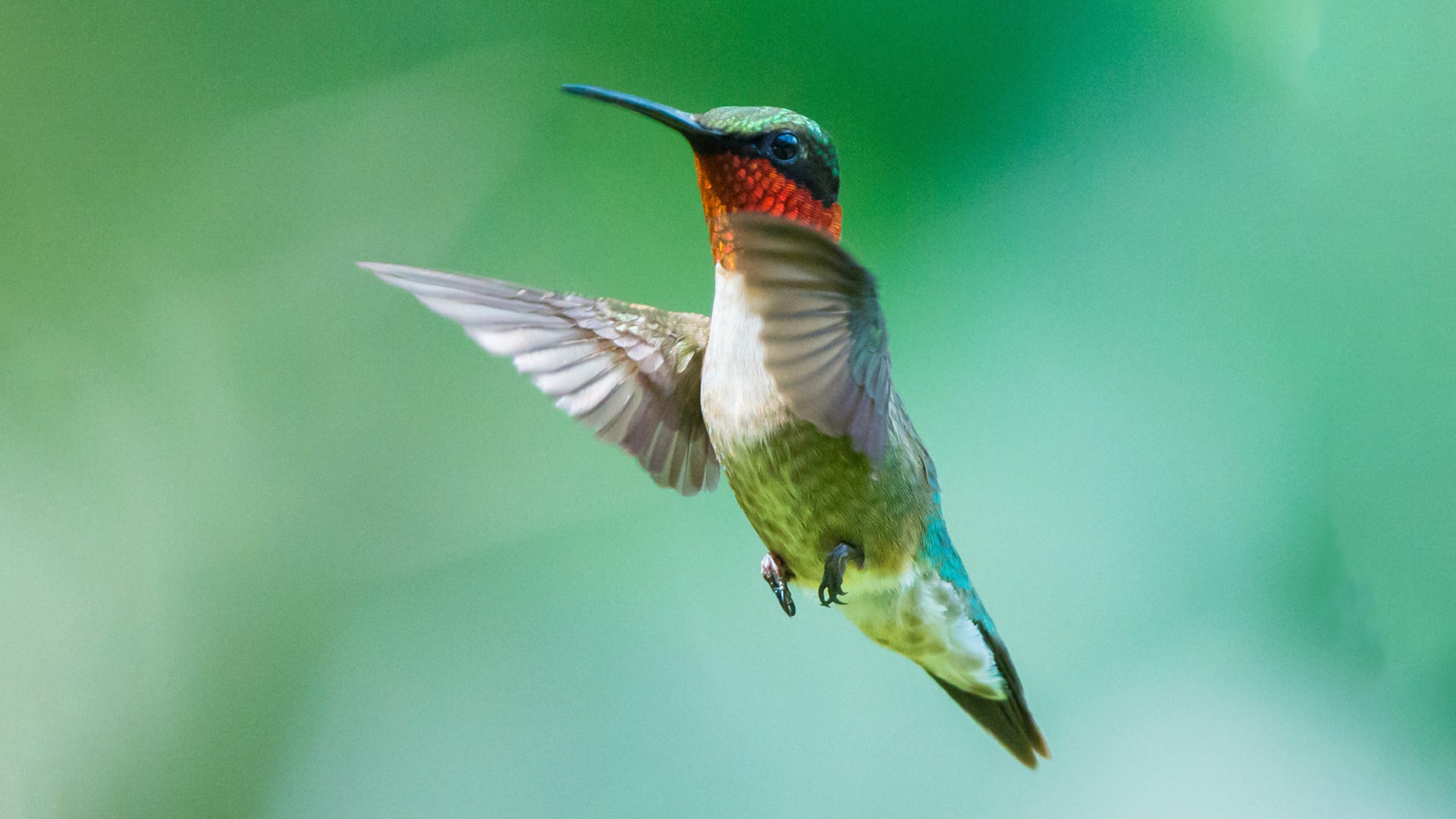Hummingbirds fly due to the unique structure of their wings and their ability to manipulate airflow. In order to understand how hummingbirds achieve such agile flight, it is important to examine the mechanics of their wings and how they generate lift.
These remarkable creatures have long, narrow wings that allow them to hover in mid-air, fly backward, and even perform acrobatic maneuvers. The rapid flapping of their wings, averaging around 50 times per second, creates lift by creating vortices and turbulent airflow.
Additionally, the flexibility and unique shape of their wings enable precise control over their flight, making hummingbirds some of the most skilled aviators in the animal kingdom.

Credit: www.scienceofbirds.com
Anatomy Of Hummingbirds
Hummingbirds’ extraordinary flight capabilities can be attributed to their unique anatomy. Their streamlined body, rapid wing flapping, and specialized wing structure enable them to hover in mid-air, fly backwards, and change direction with unmatched agility and precision. A marvel of nature’s engineering, hummingbirds exemplify the intricate mechanics behind avian flight.
Tiny and Agile: The Physique
Hummingbirds are revered for their diminutive size and remarkable agility, both of which are attributed to their unique anatomy. With an average length of just 3 to 5 inches, these tiny birds boast a compact yet powerful physique that enables them to fly with extraordinary speed and precision.
Unique Wing Structure
Central to their remarkable flight capabilities is the unique structure of hummingbirds’ wings. Unlike most bird species, hummingbirds have a highly specialized wing design that allows for unparalleled maneuverability and hovering abilities. The long primary feathers coupled with a distinctive ball-and-socket joint at the shoulder enable the birds to perform intricate aerial maneuvers with unmatched precision.
In addition, the bones in their wings are significantly elongated, and their pectoral muscles are exceptionally well-developed, providing the necessary power for sustained hovering and rapid forward flight. This remarkable wing structure, combined with rapid wing beats averaging around 50 to 80 times per second, allows hummingbirds to accomplish astonishing aerial feats that are unparalleled in the avian world.
In summary, the anatomy of hummingbirds, characterized by their compact physique and specialized wing structure, plays a pivotal role in enabling these extraordinary birds to achieve their breathtaking aerial maneuvers with unparalleled grace and agility.
Flight Mechanism
Hummingbirds possess a remarkable flight mechanism that enables them to perform extraordinary aerial maneuvers with precision and agility.
Incredible Speed And Agility
Hummingbirds are known for their incredible speed, reaching up to 60 miles per hour during flight.
Hovering Abilities
One of the most striking features of hummingbirds is their unique ability to hover in mid-air, achieved through rapid wing flapping.
“`
Incredible Speed and Agility: Hummingbirds are known for their incredible speed, reaching up to 60 miles per hour during flight.
Hovering Abilities: One of the most striking features of hummingbirds is their unique ability to hover in mid-air, achieved through rapid wing flapping.
Feeding Behavior
Hummingbirds are renowned for their unique feeding behavior, which relies heavily on their ability to collect nectar, maintain a specialized diet, and maintain a high metabolic rate.
Nectar Collection
One of the most fascinating aspects of a hummingbird’s feeding behavior is its remarkable ability to collect nectar. With their long, slender beaks and extendable tongues, hummingbirds can reach deep into flowers to extract nectar. These tiny birds are attracted to brightly colored flowers that are rich in nectar, providing them with the energy they need to sustain their incredibly high metabolic rate.
Diet And Metabolism
Hummingbirds have a unique diet that consists primarily of nectar, but they also supplement their nutrition with insects and spiders. Despite their small size, hummingbirds have a fast metabolism that requires them to consume large amounts of nectar and prey. Their metabolic rate is one of the highest of any bird species, allowing them to maintain their rapid wingbeats and perform impressive aerial acrobatics.
In order to fuel their energetic lifestyles, hummingbirds need to consume immense quantities of nectar. They can consume up to twice their body weight in nectar each day, visiting hundreds of flowers to meet their energy requirements. This intense feeding behavior allows them to maintain their hovering ability and sustain their rapid flight.
It’s important for hummingbirds to maintain a steady supply of nectar, as their fast metabolism requires a constant source of energy. They have adapted to find and exploit nectar-producing plants, often following specific migration patterns to ensure access to an abundance of flowers throughout the year.
Beyond nectar, hummingbirds also rely on insects and spiders for added protein and other nutrients. They catch their prey in mid-air or pluck them from spider webs, showcasing their agility and precision. This diverse diet helps hummingbirds meet their nutritional needs and maintain their vibrant plumage and overall health.

Credit: www.perkypet.com
Mating Rituals And Courtship
Exploring the mesmerizing world of Hummingbirds unveils their intricate Mating Rituals and Courtship that reflect their graceful flight behaviors.
Elaborate Displays
Male Hummingbirds showcase vibrant aerial acrobatics to attract female counterparts and establish dominance.
- Dives and loops in the air to captivate females’ attention.
- Sharp turns and hovering displays highlight their agility and prowess.
Sound And Visual Cues
Distinct chirping sounds accompany complex flight patterns to communicate effectively during courtship.
- Intricate dance-like movements complement musical calls for heightened communication.
Adaptations For Survival
Hummingbirds are truly remarkable creatures, boasting a variety of adaptations that allow them to survive in their unique habitats. From their vibrant feathers to their specialized beaks, these tiny birds have evolved numerous features that enable them to thrive in diverse environments. In this section, we will explore two of the most critical adaptations for their survival: migration patterns and predator evasion.
Migration Patterns
Migrating is no easy feat, but hummingbirds have mastered this complicated task. These agile birds embark on epic journeys, flying long distances to find suitable breeding and feeding grounds. Interestingly, not all hummingbirds migrate, but those that do demonstrate incredible navigation skills. They rely on their exceptional memory and orientation abilities to find their way across vast distances, navigating by landmarks or even using the position of the sun.
During migration, hummingbirds also undergo essential physiological changes. Their bodies undergo molting, which is a process of shedding old feathers and growing new ones. This allows them to maintain their ability to fly efficiently and to withstand different weather conditions. Additionally, hummingbirds undergo hyperphagia, meaning they consume large amounts of food to fuel their energy-demanding flights.
Predator Evasion
Surviving in a world full of potential threats calls for some remarkable evasion tactics. Hummingbirds have developed a range of adaptations to avoid being preyed upon. One of their most striking mechanisms is their exceptional speed. With wings that beat up to 80 times per second, hummingbirds can hover in mid-air or rapidly change direction, making them incredibly elusive targets for predators.
Another crucial adaptation is their ability to camouflage. Vibrant feathers not only make them beautiful to our eyes, but they also play an important role in blending into their surroundings. The iridescent feathers of hummingbirds reflect light in different ways, allowing them to blend in with flowers or foliage, providing them with a natural defense against predators. This natural camouflage makes it challenging for predators to spot them, increasing their chances of survival.
In conclusion, hummingbirds have evolved remarkable adaptations to ensure their survival. From their incredible migration patterns to their impressive predator evasion tactics, these tiny creatures demonstrate the ability to overcome numerous challenges. Their resilience and ability to adapt to diverse environments make them the true masters of the sky.
Conservation Efforts
Threats To Hummingbirds
Factors threatening hummingbirds’ existence include habitat loss, climate change, and pesticide exposure.
Conservation Initiatives
- Establishing protected areas to safeguard their habitats.
- Promoting native plant gardens to provide food and shelter.
- Implementing educational programs to raise awareness.
Frequently Asked Questions On How Hummingbirds Fly The Structure Of A Flight?
What Is The Flight Pattern Of A Hummingbird?
Hummingbirds have a unique flight pattern characterized by swift, agile movements. They can hover in mid-air, fly forward, backward, and even sideways. With their rapid wingbeats, hummingbirds can reach speeds up to 30 miles per hour.
What Is The Structure Of A Hummingbird’s Wings?
A hummingbird’s wings have a unique structure with long primary feathers and stiff wing bones for hovering and agility.
How Do Hummingbird Fly?
Hummingbirds fly by beating their wings up to 80 times per second, creating a figure-eight pattern. This allows them to move forward, backward, and hover with precision. Their lightweight bodies and strong chest muscles contribute to their agile and nimble flight.
What Is The Way Of Flying Of A Hummingbird?
A hummingbird flies by rapidly flapping its wings in a figure-eight pattern, allowing it to maneuver with precision and hover in place. This unique flight style enables the hummingbird to move in any direction, including backwards and upside-down, with remarkable agility.
Conclusion
To sum up, the intricate design of a hummingbird’s flight is a marvel of nature. Understanding the unique capabilities and adaptations that enable these tiny birds to maneuver with precision is truly fascinating. Next time you see a hummingbird in flight, marvel at the complexity of their aerial abilities.

